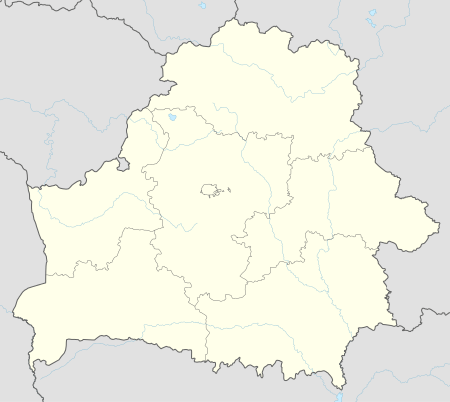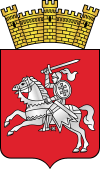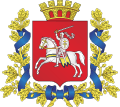Lepiel
| Lepiel Lepel | |||
|---|---|---|---|
| Лепель | |||
| |||
 Lepiel | |||
| Coordinates: 54°52′30″N 28°41′40″E / 54.87500°N 28.69444°E | |||
| Country | Belarus | ||
| Voblast | Vitebsk Region | ||
| Raion | Lepiel Raion | ||
| Mentioned | 1439 | ||
| Population (2011) | |||
| • Total | 17,280 | ||
| Time zone | EET (UTC+2) | ||
| • Summer (DST) | EEST (UTC+3) | ||
| Area code(s) | +375 2132 | ||
| License plate | 2 | ||
| Website | |||
Lepel (Belarusian: Ле́пель Lepiel; Polish: Lepel; Russian: Ле́пель, pronounced [ˈlʲepʲɪlʲ]) is a town located in the center of the Lepiel Raion (district) in the Vitebsk Province of Belarus near Lepiel Lake. Lepiel is situated at about 54°52′N 28°40′E / 54.867°N 28.667°E and its population in the 1998 census was 19,400.
.jpg)
The coat of arms of Lepel incorporates the Pahonia symbol.
Name
There are three theories about the origin of the name Lepel. The first is that the name 'Lepel' come from the word "lepene" which means "lake between the lime-groves". The second is that the name comes from the Belarusian word "лепей" meaning "the best place to live in". The third theory for the name Lepel is that it derives from the Belarusian word "ляпiць" meaning "well-developed pottery".
History
The first known mention of Lepel dates back to 1439. In the 15th century, the town belonged to the Grand Lithuanian Dukes. In 1439 thanks to efforts of a Roman Catholic priest, Kucharski, Grand Lithuanian Duke Sigismund Kęstutaitis' son Michael gave Lepel to the Vitebsk Roman Catholic church. King Sigismund I the Old subsequently confirmed the gift and in 1541 by approbation of pontiff, the townlands were given to the Vitebsk Cathedral.
After Polatsk was captured by the Russian army in 1563, the Vitebsk government was no longer able to protect its property from the attacks of the Grand Duchy of Moscow. The decision was made to donate Lepel to King Sigismund II Augustus on the erroneous assumption that the king would return the gift by awarding the Vitebsk government with other property of the same value. Instead, the king gave the property by way of life tenure to Yury Zenovich, the mayor of Smolensk. After Yury Zenovich died, Sigismund gave the town to Michael Daragastaisky and it then came into the hands of Stefan Batory. Batory eventually returned the property to the Vitebsk government when Polatsk was liberated.
It remained difficult for the Vitebsk authorities to protect their holdings in Lepel and thus the decision was made in 1586 to sell the townlands to Lew Sapieha, a leading politician. Sapieha eventually donated Lepel in 1609 to Bernardine nuns in Vinius (Wilno) who lived next to St. Michael's Church.
After the annexation of Belarus to Russia in 1772, Lepel remained in Lithuania due to the border being traced by the river Dvina. After the second division of the Polish-Lithuanian Commonwealth in 1793, Lepel was joined to Russia and in 1802 the town became the center of the region. The town suffered greatly in the 1812 French invasion of Russia thanks to passing troops razing many buildings to the ground. On 9 September 1852 Lepel was awarded its own coat of arms. Jan Czeczot worked for the direction of channels in Lepel during the period 1833-1839. In 1880 population of Lepel consisted from 5284 people, including 2458 Jews, 2281 Orthodox, 536 Roman Catholics.
By 1913 Lepel had lost its strategy and trade concernment and was a quiet and typically regional town center.
On November 10, 1919 in the neighbourhood of Lepel there was a clash between the company of the 13th infantry regiment of the Polish Army sitting in an ambush and the Soviet troops penetrating the region. The fighting was successful for the Poles still the commanding officer - leuthenant Stanisław Jacheć was the only Polish victim of the clash. Heavy fightings between the bolshevik troops and the Polish Army (30th regiment of the Rifles of Kaniów of XX brigade) continued all the November 1919 and the Polish-Soviet frontline was established there until spring 1920.
In the fall of 1941 and in February 1942,[1] Jews of the town are murdered in mass executions perpetrated by an Einsatzgruppen.[2]
Education
Lepel has:
- 4 secondary schools
- An agrotechnical college
- A professional college
Transportation
Lepel is situated on a highway connecting Minsk and Vitebsk; 115 km from Vitebsk, 155 km from Minsk. Also there is a road to Polatsk. Connected by the railway to Orsha.
References
External links
- Photos on Radzima.org
- http://www.newlepel.com - unofficial site
- http://www.mylepel.info - history of the town, community
- Lepel in Geographical Dictionary of Polish Kingdom and Other Slavic Countries(Polish)
- The murder of the Jews of Lepiel during World War II, at Yad Vashem website.


